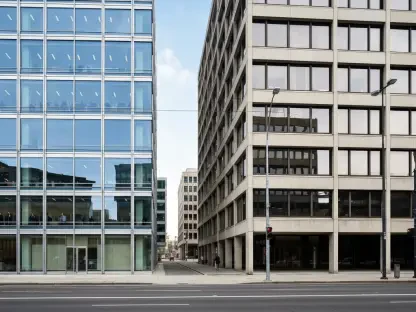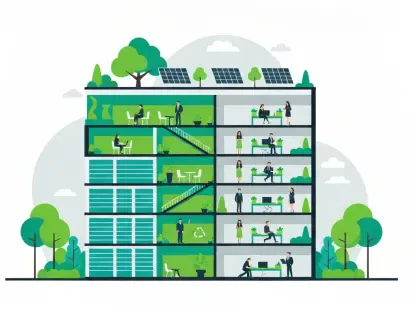Imagine a region where public buildings, from schools to hospitals, become beacons of sustainability, slashing carbon emissions while improving occupant comfort. This vision is becoming a reality in Greater Manchester, where a £28 million Public Building Retrofit Fund (PBRF), led by the Greater Manchester Combined Authority (GMCA), is driving decarbonization across public sector infrastructure. This initiative stands as a cornerstone in the fight against climate change, reflecting a growing industry trend toward energy efficiency and low-carbon solutions in public spaces.
The urgency of such programs cannot be overstated, as heating in buildings accounts for a significant portion of greenhouse gas emissions in the UK. With public sector buildings often relying on outdated, fossil fuel-based systems, retrofitting offers a tangible path to reducing environmental impact. GMCA’s ambitious fund not only addresses this challenge but also positions the region as a leader in sustainable infrastructure, setting an example for other areas to follow.
This industry report delves into the mechanics of this transformative initiative, exploring how partnerships and expertise are shaping the retrofit landscape. Key players like Salix Finance are pivotal, bringing technical know-how to ensure the fund’s success. As the drive for net zero intensifies, understanding these efforts provides critical insights into the future of public sector decarbonization.
Detailed Analysis of the Retrofit Initiative
Understanding the Public Building Retrofit Initiative
The £28 million PBRF, administered by GMCA, targets the installation of low-carbon heating systems and energy efficiency measures in public buildings across Greater Manchester. This substantial investment aims to cut carbon emissions significantly, aligning with the region’s goal of achieving net zero by 2038, well ahead of the national target of 2050. Public sector buildings, often large contributors to local emissions, are prioritized for upgrades to improve sustainability and reduce operational costs.
Beyond environmental benefits, this initiative underscores the importance of regional action in combating climate change. GMCA’s leadership in managing the fund highlights how devolved powers enable tailored solutions to local challenges, while still contributing to broader UK climate objectives. The program’s focus on decarbonization reflects a growing recognition of the need to modernize aging infrastructure for a greener future.
Salix Finance emerges as a crucial partner in this endeavor, offering technical expertise to assess funding applications and ensure resources are allocated effectively. Their involvement, combined with GMCA’s administrative oversight, creates a robust framework for project success. This collaboration exemplifies how specialized knowledge can enhance regional efforts, paving the way for impactful environmental outcomes.
The Role of Salix Finance in Decarbonization Efforts
Technical Expertise and Support
Salix Finance plays an indispensable role by conducting detailed technical assessments for PBRF funding applications. Their rigorous evaluation process ensures that proposed retrofit projects are both feasible and capable of delivering maximum carbon reduction. With a proven track record in managing the Public Sector Decarbonization Scheme, Salix brings a wealth of experience to the table, strengthening the quality of GMCA’s initiatives.
This expertise is vital for navigating the complexities of retrofitting diverse building types, from historic structures to modern facilities. By providing data-driven insights, Salix helps prioritize projects that offer the greatest environmental return on investment. Their support extends beyond mere assessment, fostering confidence among stakeholders that funds are being utilized efficiently.
The commitment to effective resource allocation is evident in their structured approach to funding rounds, with initial applications already underway. This methodical process, underpinned by Salix’s technical acumen, ensures that the £28 million fund translates into real-world reductions in energy use and emissions. Their role is a linchpin in turning ambitious goals into measurable progress.
Broader Mission and Impact
Beyond Greater Manchester, Salix Finance is dedicated to supporting the UK’s net zero target by 2050, as emphasized by Chief Executive Kevin Holland. Their mission focuses on scaling decarbonization efforts across the public sector, with projects spanning various regions and building types. This expansive vision positions Salix as a key player in the national push for sustainability.
The partnership with GMCA serves as a blueprint for how specialized organizations can collaborate with regional authorities to achieve climate goals. By leveraging their expertise, Salix not only enhances local projects but also contributes to a growing network of decarbonization initiatives. Their influence is expanding, with more public sector entities seeking their guidance for similar retrofit programs.
This model of collaboration highlights the potential for scalable impact, where lessons learned in one region can inform strategies elsewhere. Salix’s involvement in Greater Manchester demonstrates a synergy between technical support and local governance, creating a replicable framework for other areas aiming to reduce their carbon footprint.
Challenges in Retrofitting Public Buildings
Retrofitting public infrastructure presents a host of challenges, primarily due to the high costs associated with replacing fossil fuel-based heating systems. Many buildings require extensive upgrades to accommodate low-carbon alternatives, often straining limited budgets. These financial constraints can delay projects or limit their scope, posing a significant barrier to widespread decarbonization.
Logistical hurdles further complicate the process, as public buildings vary widely in age, design, and condition. Coordinating stakeholders, from building managers to contractors, adds another layer of difficulty, especially when balancing operational continuity with construction demands. These issues underscore the need for meticulous planning and robust support systems to ensure project completion.
Strategies to overcome these obstacles include structured funding rounds, as implemented by GMCA, to manage resource distribution effectively. Technical assistance from partners like Salix Finance also plays a critical role in addressing site-specific challenges through tailored solutions. By combining financial and technical support, the industry can better navigate the complexities of retrofitting, ensuring sustainable outcomes.
Alignment with Climate Policies and Regulations
The PBRF operates within a well-defined regulatory framework, aligning with the UK’s national net zero goal of 2050 and Greater Manchester’s accelerated target of 2038. This alignment reflects a dual commitment to local and national priorities, emphasizing the role of regional initiatives in broader climate strategies. Policies driving energy efficiency are central to the fund’s objectives, focusing on measurable reductions in emissions.
Devolution empowers GMCA to tackle local climate challenges with customized approaches, while still contributing to the UK’s overarching environmental agenda. This flexibility allows for targeted interventions, such as retrofitting buildings responsible for a notable share of emissions—specifically, the 9% attributed to heating. Regulatory support ensures that these efforts are both compliant and impactful.
The emphasis on reducing emissions from building heating aligns with industry trends prioritizing energy efficiency as a key decarbonization lever. Government policies continue to incentivize such measures, providing a supportive backdrop for initiatives like the PBRF. This synergy between regulation and action fosters an environment where sustainable upgrades are not just encouraged but actively facilitated.
Future Prospects for Green Retrofits in Greater Manchester
Looking ahead, the PBRF holds immense potential to transform energy consumption patterns in Greater Manchester’s public buildings. By implementing low-carbon heating and efficiency measures, the fund is expected to yield significant reductions in carbon emissions over the coming years. This progress could redefine how public spaces operate, prioritizing sustainability without compromising functionality.
Emerging technologies, such as advanced heat pumps and smart energy management systems, are likely to shape the next phase of retrofit projects. These innovations promise to enhance the efficiency and cost-effectiveness of upgrades, making widespread adoption more feasible. As these solutions mature, they could further accelerate the region’s journey toward net zero.
The success of this initiative may also inspire similar programs across other UK regions, leveraging devolved powers and partnerships to scale decarbonization efforts. Industry forecasts suggest growing public demand for sustainable infrastructure, coupled with policy support, will drive further investment in green retrofits. Greater Manchester’s model, bolstered by collaboration with entities like Salix Finance, could become a catalyst for nationwide change.
Reflections and Path Forward
Looking back, the partnership between Salix Finance and GMCA proved to be a powerful alliance in advancing the £28 million Public Building Retrofit Fund. Their combined efforts tackled significant challenges in decarbonizing public sector buildings, setting a strong foundation for environmental progress in Greater Manchester. The initiative’s alignment with both regional and national climate goals demonstrated the value of localized action within a broader framework.
Moving forward, stakeholders should prioritize sustained investment in retrofit programs, exploring innovative financing models to address cost barriers. Integrating cutting-edge technologies and fostering cross-regional collaborations can amplify impact, ensuring that lessons from this project benefit a wider audience. Industry leaders must also advocate for policies that streamline such initiatives, reducing bureaucratic hurdles.
Ultimately, the path ahead lies in building on this momentum, encouraging other regions to adopt similar frameworks while continuously refining best practices. By focusing on scalability and adaptability, the industry can turn isolated successes into a collective movement toward a sustainable future, ensuring public buildings lead the charge in carbon reduction.









